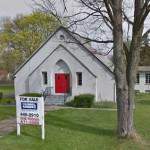FOR SALE
 FOR SALE. There it was, standing in the front yard of the church. A ‘for sale’ sign. Sad. So very sad. St. Thomas Episcopal Church, in the New York village of North Syracuse, or that it is what it once was. Now it’s just an abandoned building, although to me it will always be a church; the memories can never be erased. Sitting there among the weeds, it looks lonely, full of its own memories of when it was a thriving church with the pews filled every Sunday. Now abandoned. When the church closed its doors several years ago there was hope that another religious group might adopt the church, but that was just a dream. Local church-related websites still include the church among the living, which makes the sadness all the more. The home for the priest and his family has been razed, leaving the churchyard all the more stark and alone.
FOR SALE. There it was, standing in the front yard of the church. A ‘for sale’ sign. Sad. So very sad. St. Thomas Episcopal Church, in the New York village of North Syracuse, or that it is what it once was. Now it’s just an abandoned building, although to me it will always be a church; the memories can never be erased. Sitting there among the weeds, it looks lonely, full of its own memories of when it was a thriving church with the pews filled every Sunday. Now abandoned. When the church closed its doors several years ago there was hope that another religious group might adopt the church, but that was just a dream. Local church-related websites still include the church among the living, which makes the sadness all the more. The home for the priest and his family has been razed, leaving the churchyard all the more stark and alone.
The sadness is not that the building stands idle; the building was but an icon of a societal element. That societal element was the real loss: the people and the compassion they shared. Where did they go? Did they lose the passion? The building stands as a grave marker to a life now gone. I cannot look at this church with disinterested eyes; it was once a huge part of my life. When my family and I first moved to that village we lived just a block away. Within a week of arrival we had a visit from the priest and I volunteered to teach the second grade with assistance from my wife. Although we had never been inside the church we were now a part of it.
From my perspective, St. Thomas Church was likely referred to as a “low church”. I say that because there was always a buzz of soft chatter as people assembled prior to the service. In a “high church” there would be silence. Looking at the church now it seems small, much as the back yard of your childhood may seem small when visited later as an adult. There was a time when that church was so big to me, so full and expansive, yet now seems small. Memories of the children come to mind, of our leading them downstairs for Sunday School prior to the sermon. (One of my early discoveries of the Episcopal Church was that, while the sermon was the major element in the church of my youth, it was secondary to the Episcopal service–and I liked that.)
Each week I reacted to the challenge of preparing a lesson that would engage the children. With my dear wife’s assistance we discovered their interest and openness, finding that we were growing even as did they. At the school year’s end the parents asked us to stay on, but it wasn’t to be. With other issues in our lives, we left the Sunday School. And, within a year we had left the church, returning only occasionally. Eventually, we were gone. Were we the first brick to fall from the wall? Was our leaving part of why the church now stands in weeds?
Sadly, I must admit that I am part of the reason the church is now closed. When we leave a group, it may seem a small gesture because so many remain, but each loss is felt by the others. Over time, the departures mount. Eventually, the organization reaches the point where it cannot sustain itself, where there are too few to fill the needed roles, and where the fellowship that made the church whole is gone. And the church dies. And I stand guilty of its death.
